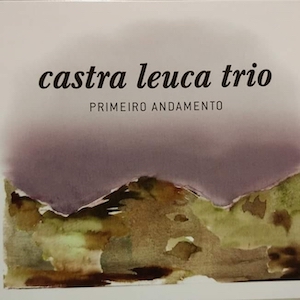 Castra Leuca Trio – Premeiro Andamento
Castra Leuca Trio – Premeiro Andamento
Self Released – Out Now
In respect of Portuguese traditional/folk music, the most widely known, outside of the country itself, is likely to be fado, courtesy of Amália Rodrigues, and more recently Mariza, along with Cante Alentejano, both of which are on the UNESCO Intangible Cultural Heritage List. Regional folk music in other areas, however, continues to thrive, the north-eastern region of Trás-os-Montes, with its gaitas-de-fole, (bagpipes) and a cappella vocals, sounding similar to the music of Asturias, Cantabria and Galicia in Spain, and the traditional music of The Azores and Madeira being notable. It is such a great pleasure, therefore, to discover new interpretations of music from a lesser-known region which only features occasionally in my collection via artists such as Brigada Victor Jara and Dazkarieh, played by a group hitherto unknown to me.
The Castra Leuca Trio hail from Castelo Branco, the provincial capital of the historic mountain province of Beira Baixa, with its parched and scenic landscapes, situated in the region of Centro de Portugal and birthplace of António Guterres, Secretary-general of the United Nations. The group’s line-up, which, perhaps surprisingly, is rare if not unique in Portugal, features Joaquim Pires on guitar, Nicolas Ramirez Celis, violin and Antonio Pedro Dias, percussion. In the short space of fewer than two years the group appear to have rapidly made a mark on the Portuguese world-music scene, establishing itself through performances throughout both their home country and Spain, appearing at the Sons da Terra Festival, the Zeca Afonso Festival, the Água Mole em Pedra Dura Festival and the Avante! Festival, named after the Portuguese Communist Party newspaper, to name but a few.
2019 sees the release of Primeiro Andamento, their first album. Recorded, mixed and mastered by Luis Marques at the College of Applied Arts studio at the state-run Castelo Branco Polytechnic Institute, and featuring some wonderful watercolour artwork from Ines Brito, the album’s title translates as “First Movement”, an entirely apposite description on more than one level, for a release which captivates on first hearing and reveals so much more on repeated airings.
All of the tracks on the CD come from traditional Portuguese melodies, (how much better does this sound as ‘Música Tradicional Portuguesa’?). Most of them originate from Beira Baixa, and have been transformed in various ways in arrangements which have all been scored, so expertly, by Joachim, and played, so beautifully, by the trio. By eschewing lyrics throughout, it might be thought that there would be a dilution of the impact and power often present in other versions of the songs; the quality of the music offered, however, renders this merely a point of conjecture.
Opening track, Senhora do Almurtão, one of several religious songs, sets the tone for the rest of the album perfectly. The introductory, doleful notes on the violin are followed by acoustic guitar and then simple percussion, before the tune gathers tempo and pace as the strident beats of the adufe, the square tambourine of Moorish origin, lead the tune to its climax. A similar technique is exploited, again to great effect, with Eras Tão Bonita, as the gentle, lilting opening develops with a delightful melody on a song also known as Cantiga Bailada before a dramatic ending.
The two following tracks, Cantiga de Ceifa and Meninas Vamos à Murta are both working songs. The former, which translates as Harvest Song, certainly creates a pastoral image, although this violin-dominant arrangement is far removed from the version of the song released by Lua Extravagante. After an andante-like start, Meninas Vamos à Murta, (Girls going for myrtles), evolves into a toe-tapping, exuberant tune which is almost eastern European in feel, a wonderfully energetic offering.
The celestial Menino Jesus leads seamlessly into the up-tempo Tirioni, before Senhora do Carmo, with its fascinating sound effects and percussion, again highlights Nicolas’s skill on violin, with a melody that lingers long. Two more religious songs follow. The upbeat, jaunty opening to Loureiro/Senhora da Consolaçãoi will bring a smile to the face before the tune morphs into the most un-hymn-like tune you could ever wish to hear. Building to a crescendo, it really rocks as it confounds and belies its origins as a hymn.
The final two tracks on the album change the mood and tempo once again. Santa Bárbara, with its repetitive guitar phrases, mournful violin and efficacious percussion is hauntingly moving. The use of what appears to be a rain stick adds to the overall effect. Continuing in the same vein, Ai Solidon/ Bento Airoso, the latter a Portuguese Christmas song, is melancholy personified. You might struggle to find a more lacrymal, (in the nicest, most positive way), 4 minutes 34 seconds anywhere.
My knowledge of the geographical area from which most of this music is culled is such that one word above all others is used in conversation, ‘protection’. The past and the future are inexorably linked by the desire to protect each and every aspect of the region’s heritage. From the hills and the valleys, The Castra Leuca Trio proudly take the traditional and popular songs from the Cancioneiro, (song collection), thus preserving and respecting the culture of the past, but interpret in new ways, moving from classical to jazz and beyond, both honouring and promoting the ethnography.
Premeiro Andamento is a high-class debut album featuring consummate musicianship.
https://www.facebook.com/castraleucatrio/

